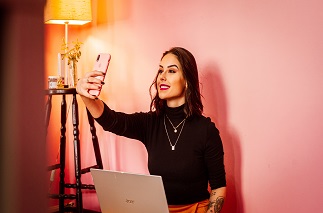Posts

Girl YouTubers: Interaction, creation, and emotions during COVID-19 confinement
The COVID-19 pandemic forced absolute confinement in Spain from March 15 to July 21, 2020. On the other side of the screen, YouTubers girls and boys, creators of specific content for their peers, took the opportunity to increase their productions. This research examines 73 creations made during the confinement period by six Spanish girls YouTubers categorized as influencers by the number of reproductions and followers of their channel sthrough content analysis to evaluate the interactions, the content generated, and subjective aspects of projection of the emotional state of these minors. The results show increased interactors, positioning the female sector as the most prevalent gender. The contents have been related to the COVID-19 theme, while, in the emotional aspect, the influencers were not affected by the great sadness that hit Spain with the death of thousands of people.

Corporate visual identity of financial institutions in Spain: iconographic-symbolic web content analysis
This research examines the visual identity of the 72 leading financial institutions operating in Spain through an ad hoc analysis model of iconographic-symbolic content. For this purpose, an analysis sheet is designed and validated, with theoretical variables where each sample object responds to categories grouped by similarity and under formal criteria obtained from the study of all the literature related to the fundamental graphic elements –iconic, linguistic, and plastic sign– and their application to the virtual world. The results show that legibility and modernity are priorities in the majority of the sample corpus, with a typographic style without finials, simple strokes, capital, round and medium-thickness characters. In addition, the entities prefer other values apart from professionalism and stability, such as closeness or trust, making use in the compositions of a quality range of 2-3 color combinations in which the balance between cold and warm colors is appreciable. For the sake of responsive web design, financial institutions are inclined to stay on the sidelines and not do without any elements in their visual identities, leading the way in the use of logotypes

Toward state-of-the-art on social marketing research in user-generated content (UGC) and influencers
This study examines the research that has been conducted on user-generated advertising content in the social marketing strategies of commercial brands to understand the phenomenon, explore academic interest in the topic and identify areas of limited thematic coverage. A systematic review of existing scientific literature in the Web of Science (WoS) and Scopus was carried out using the PRISMA protocol. A co-occurrence matrix was used to review emerging topics on user-generated content (UGC) and influencer marketing, allowing the identification of articles (n = 59) related to the objective of this research. Most research has analyzed UGC in images or text, but only very few have addressed videos and other digital formats (such as reels, image carousels or podcasts), although there is sufficient work focused on Twitter, Facebook and YouTube. There was no evidence of work exploring the effects, repercussions and possible dangers of uncontrolled brand exposure through Unofficial Brand Ambassadors. The literature review has allowed finding important areas of future research that the scientific community has not sufficiently addressed. Likewise, this work shows structurally several classifications of UGC, which will facilitate future research to deepen and broaden these categories.

OK, Boomer: New Users, Different Platforms, New Challenges
The popularization of new interaction spaces brings new narratives and social phenomena that merit attention from the scientific community. Based on the existing literature on the new challenges facing the communication discipline with these emerging narratives, this editorial summarizes the empirical and theoretical contributions of the thematic issue entitled “New Narratives for New Consumers: Influencers and the Millennial and Centennial Generations.” The authors emphasize that the studies selected for this thematic issue explore the innovative features and opportunities of the emerging scenarios and offer a cautionary account of their structural problems and the urgency of a new media literacy.

Hola Followers! Content Analysis of YouTube Channels of Female Fashion Influencers in Spain and Ecuador
The objective of this article is to analyze the contents and unconventional advertising narratives of the eight most important women in the world of fashion in Spain and Ecuador in relation to the number of followers and points of view, in order to identify the discursive and esthetic strategies and narratives that may reflect the keys to their experience as prescribers, through a content analysis based on the interpretation of the five most viewed videos between 2018 and 2019 from four Spanish to four Ecuadorian YouTube channels (ME = 40) based on a three-round Delphi analysis sheet with a validity of W = 0.828 and α = .947. The content is analyzed from a qualitative perspective, which allows an in-depth exploration of the dimensions and indicators of impact and influence on YouTube channels. The research presents the findings that the influencers reviewed use crutches, idioms, and set phrases to identify with their audience. The audiovisual narrative is simple, maintaining its amateur style. Advertising positioning in the channels analyzed is given by identifying the brand in the spoken discourse, the presence of brand logos, advertisements and promotions, and the presence of products of the sponsoring brands.
